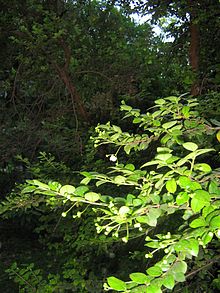
Liriodendron is a genus of two species of characteristically large trees, deciduous over most of their populations, in the magnolia family (Magnoliaceae).

Araucaria heterophylla is a species of conifer. As its vernacular name Norfolk Island pine implies, the tree is endemic to Norfolk Island, an external territory of Australia located in the Pacific Ocean between New Zealand and New Caledonia. It is not a true pine, which belong to the genus Pinus in the family Pinaceae, but instead is a member of the genus Araucaria, in the family Araucariaceae, which also contains the monkey-puzzle tree. Members of Araucaria occur across the South Pacific, especially concentrated in New Caledonia where 13 closely related and similar-appearing species are found. It is sometimes called a star pine, Polynesian pine, triangle tree or living Christmas tree, due to its symmetrical shape as a sapling.
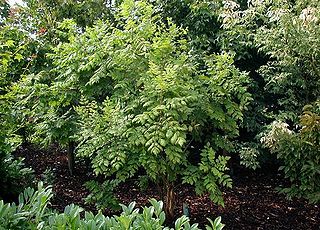
Koelreuteria, also known as chinese lantern tree, is a genus of three species of flowering plants in the family Sapindaceae, native to southern and eastern Asia.

Abies concolor, the white fir or Colorado fir, is a coniferous tree in the pine family Pinaceae. This tree is native to the mountains of western North America, including the Cascade Range and southern Rocky Mountains, and into the isolated mountain ranges of southern Arizona, New Mexico, and Northern Mexico. It naturally occurs at elevations between 900 and 3,400 metres.

Conocarpus erectus, commonly called buttonwood or button mangrove, is a species of mangrove shrub in the family Combretaceae. It grows on shorelines in tropical and subtropical regions around the world.

Glyptostrobus is a small genus of conifers in the family Cupressaceae. The sole living species, Glyptostrobus pensilis, is native to subtropical southeastern China, from Fujian west to southeast Yunnan, and also very locally in northern Vietnam and Borikhamxai Province of eastern Laos near the Vietnam border.

Dermatophyllum is a genus of three or four species of shrubs and small trees in the subfamily Faboideae of the pea family, Fabaceae. The genus is native to southwestern North America from western Texas to New Mexico and Arizona in the United States, and south through Chihuahua, Coahuila, and Nuevo León in northern Mexico. Members of the genus are commonly known as mescalbean, mescal bean, or frijolito. One of the common names of Dermatophyllum secundiflorum is Texas mountain laurel, although the name mountain laurel also refers to the very dissimilar and unrelated genus Kalmia and the name laurel refers generally to plants in the unrelated order Laurales.

Luma apiculata, the Chilean myrtle or temu, is a species of flowering plant in the myrtle family, native to the central Andes between Chile and Argentina, at 33 to 45° south latitude. Growing to 10–15 m (33–49 ft) tall and wide, it is a vigorous, bushy, evergreen tree with fragrant flowers.

Cornus racemosa, the northern swamp dogwood, gray dogwood, or panicle dogwood, is a shrubby plant native to southeastern Canada and the northeastern United States. It is a member of the dogwood genus Cornus and the family Cornaceae.

Quercus acutissima, the sawtooth oak, is an Asian species of oak native to China, Tibet, Korea, Japan, Indochina and the Himalayas. It is widely planted in many lands and has become naturalized in parts of North America.
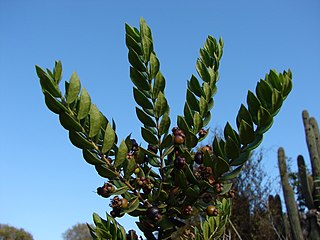
Luma chequen, the white Chilean myrtle, is a species of flowering plant in the genus Luma in the family Myrtaceae, native to the central Andes mountains between Chile and Argentina, at latitudes located 30 to 41° South. Synonyms include Eugenia chequen Molina, Myrtus chequen (Molina) Spreng., and Luma gayana (Barn.) Burret. Common names in Spanish include chequén, huillipeta, and arrayán blanco.

Purshia is a small genus of 5–8 species of flowering plants in the family Rosaceae which are native to western North America.

Juniperus deppeana is a small to medium-sized tree reaching 10–15 metres in height. It is native to central and northern Mexico and the southwestern United States.
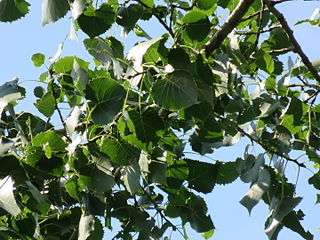
Populus deltoides, the eastern cottonwood or necklace poplar, is a cottonwood poplar native to North America, growing throughout the eastern, central, and southwestern United States as well as the southern Canadian prairies, the southernmost part of eastern Canada, and northeastern Mexico.
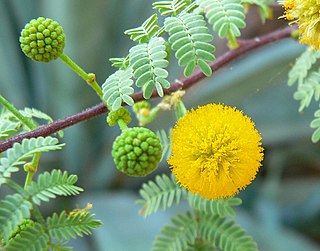
Vachellia constricta, also known commonly as the whitethorn acacia, is a shrub native to Mexico and the Southwestern United States, with a disjunct eastern population in Virginia and Maryland.

Leucothrinax morrisii, the Key thatch palm, is a small palm which is native to the Greater Antilles, northern Lesser Antilles, The Bahamas and Florida and the Florida Keys in the United States.
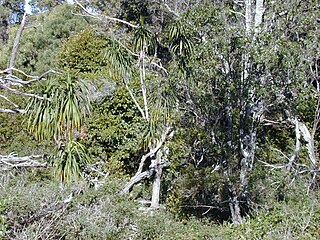
Dracaena aurea, the golden hala pepe, is a species of flowering plant that is endemic to the island of Kauaʻi in Hawaii. It inhabits coastal mesic and mixed mesic forests at elevations of 120–1,070 m (390–3,510 ft). It is a small evergreen tree, usually 4.6–7.6 m (15–25 ft) tall, but sometimes reaches 12 m (39 ft). The gray, straight trunk does not have bark and is 0.3–0.9 m (0.98–2.95 ft) in diameter. The sword-shaped leaves are 20–51 cm (7.9–20.1 in) long and 1–3 cm (0.39–1.18 in) wide.

Amomyrtus luma, known as luma, is a species of tree in the family Myrtaceae. It is native to Chile and Argentina. It grows from Colchagua to Aysen. This species occurs in rainforests, near streams, and in other moist sites.

Sapindus saponaria is a small to medium-sized deciduous tree native to the Americas. Common names include wingleaf soapberry, western soapberry, jaboncillo, sulluku and manele and a'e (Hawaiian). Its genus name, "Sapindus", comes from the Latin, meaning Indian soap, and its specific epithet means "soapy."

Notholithocarpus densiflorus, commonly known as the tanoak or tanbark-oak, is a broadleaf tree in the family Fagaceae, and the type species of the genus Notholithocarpus. It is native to the far western United States, particularly Oregon and California. It ranges from 15–40 meters in height, with a trunk diameter of 60–190 centimeters.
